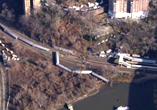 A New York City commuter train rounding a riverside curve derailed Sunday, killing four people and injuring more than 60 in a crash that threw some riders from toppling cars and raised questions about whether excessive speed, mechanical problems or human error could have played a role.
A New York City commuter train rounding a riverside curve derailed Sunday, killing four people and injuring more than 60 in a crash that threw some riders from toppling cars and raised questions about whether excessive speed, mechanical problems or human error could have played a role.
Some of the roughly 150 passengers on the early morning Metro-North train from suburban Poughkeepsie to Manhattan were jolted awake around 7:20 a.m. to screams and the frightening sensation of their compartment rolling over on a bend where the Hudson and Harlem rivers meet in the Bronx.
All of the train’s seven cars came off the track about 100 feet north of the Spuyten Duyvil station around 7:20 a.m., officials said.The incident is just the latest example of this year’s troubles for the second-biggest U.S. commuter railroad.
“Four people lost their lives today in the holiday season, right after Thanksgiving,” New York Gov. Andrew Cuomo said at a news conference.
Three of the dead were found outside the train, and one was found inside, authorities said. MTA police identified the victims as Donna L. Smith, 54, of Newburgh, N.Y.; James G. Lovell, 58, of Cold Spring, N.Y.; James M. Ferrari, 59, of Montrose, N.Y.; and Ahn Kisook, 35, from the New York City borough of Queens.
Lovell, an audio technician, was traveling to midtown Manhattan to work on the famed Christmas tree at Rockefeller Center, friend Janet Barton told CBS New York.
Fire officials said 11 of the more than 60 people injured were critically wounded, but New York Mayor Michael Bloomberg said late Sunday that none of their injuries was believed to be life-threatening.
In their efforts to find passengers, rescuers shattered windows, searched nearby woods and waters and used pneumatic jacks and air bags to peer under wreckage. Crews planned to bring in cranes during the night to right the overturned cars on the slight chance anyone might still be underneath, National Transportation Safety Board member Earl Weener said.
But law enforcement sources said that Rockefeller, in spontaneous comments made to first responders, said he applied the brakes as the train rounded the curve but the brakes did not work.
Cuomo said the track did not appear to be faulty, leaving speed as a possible culprit for the crash, but he noted that the National Transportation Safety Board would determine what happened.
Metropolitan Transportation Authority Chairman Thomas F. Prendergast said investigators would look at numerous factors, including the train, the track and signal system, the operators and speed.
The speed limit on the curve is 30 mph, compared with 70 mph in the area before the curve, MTA spokeswoman Marjorie Anders said.
Several injured passengers told both WCBS New York and The Associated Press that the train seemed to be going too fast as it took the curve near the Spuyten Duyvil station. The station’s name comes from a Dutch word for a local waterway, sometimes translated as “Devil’s whirlpool.”
Investigators did not know how fast the train was traveling but said they had recovered a data recorder.
CBS News correspondent John Miller reported that law enforcement officials do not suspect foul play at this time.
Authorities were trying to determine whether everyone on the train had been accounted for. Unlike an aircraft, with an airtight manifest that lists everyone on the plane once the doors closed, trains are harder to track. People get on and off and not everyone who bought a ticket ends up on board. A review of computer records on ticket sales and stubs from the conductor will be used to build a complete witness list.
While some passengers were headed to work, others aboard the train were probably going to New York for holiday shopping – and many more might have joined them had the train been later in the morning.
Read more at CBS NEWS.
{Matzav.com Newscenter}











